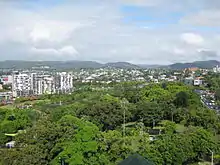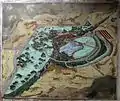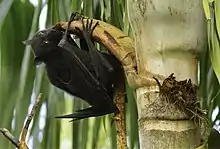Roma Street Parkland
Roma Street Parkland covers 16 hectares in the centre of Brisbane, Australia. The Roma Street Parkland is adjacent to Brisbane Transit Centre and the Roma Street railway station from which it takes its name (the park does not directly face onto Roma Street) There is pedestrian access to the Roma Street Parkland from the Roma Street railway station, as well as from Albert Street, and from the section of the Parkland which used to be called Albert Park, in Wickham Terrace.
| Roma Street Parkland | |
|---|---|
.jpg.webp) Roma Street Parklands looking towards the Brisbane CBD | |

| |
| Location | Brisbane, Australia |
| Area | 16 hectares (40 acres) |
| Created | 6 April 2001[1] |
| Operated by | City Parklands Transition Services Pty Ltd through Brisbane City Council,[1] |

There is also a car park area, with road access from the intersection between Wickham Terrace, College Road and Gregory Terrace. Roma Street Parkland is the world's largest subtropical garden in a city centre.[2] The parkland features a variety of themed gardens and recreational areas, with a web of pathways and boardwalks traversing cascading waterways and rocky outcrops, and also in situ artworks by 16 local artists.
History of Roma Street Parkland area
Local Indigenous people used the area for thousands of years conducting meetings and ceremonies.
In 1825 the Roma Street Parkland area was part of the original Brisbane settlement. In 1875 a railway terminal station in Roma Street was constructed as part of the Main Line railway linking Brisbane to Ipswich and Toowoomba.
The terminal grew to become a major goods yard for Brisbane and, between 1911 and 1934, the area was extensively redeveloped to support its increase in services. In 1920 extensive excavation, removing 554,300 cubic meters of earth, permanently altered the steep terrain creating the current day artificial escarpment and the boundary of the former Albert Park. During World War II, the terminal was vital for transporting war materials and military personnel north.
Continuing to grow, the Roma Street railway station was redeveloped to service a metropolitan and long-distance train network. Because of limitations of the site revealed through the increasing mechanization of freight handling and the use of containers, the facility was eventually relocated to Acacia Ridge in 1991.
In February 1995, State Premier Wayne Goss announced the railway goods yard would be redeveloped as parkland.[3] Construction began in 2000 with the parkland opened to the public in 2001.[4] The project won its first award before it had opened: a commendation in the Cement and Concrete Association of Australia Streetsmart awards for the innovative concrete finishes created by the use of coloured concrete and an apparently random pattern of rough cast concrete generated by the formworkers which makes the finish appear to change through the day depending on the angle of the sun and the length of shadows cast by the detailing on the walls. The technique was created through a design and construction collaboration between project designers PARC managing contractor Abigroup and the Queensland Department of Public Works.[5]
Amphitheatre

Roma Street Parkland has an open air amphitheatre, previously called the Albert Park Amphitheatre, which had been a feature of Albert Park for a number of decades before the Roma Street Parkland was established.
Outdoor film exhibitor, Moonlight Cinema holds a licence to operate an outdoor cinema experience within the park; offering hot food, beverages, film festivals, and many other activities during summer months annually.
Plays are performed at the Amphitheatre by the Queensland Theatre Company, and the Queensland Shakespeare Ensemble, as well as by other theatre groups, with many plays by William Shakespeare having been performed at the amphitheatre.[6]
Other theatre productions, including orchestral concerts, have also been performed there. One such concert, in which the music was by Johann Strauss, was called "Strauss Beneath the Stars", which was presented in October 1983.
The Lord Mayor's Christmas Carols, Brisbane's Carols by Candlelight concerts, were held at the Albert Park Amphitheatre before Riverstage was built in the City Botanic Gardens.
Gallery
 Mosaic map of the park
Mosaic map of the park Map of the park
Map of the park Fern Gully
Fern Gully Water feature
Water feature Eastern water dragon in the park.
Eastern water dragon in the park. Rainbow lorikeet (Trichoglossus haematodus) in the parklands.
Rainbow lorikeet (Trichoglossus haematodus) in the parklands. Juvenile Eastern water dragon in the park.
Juvenile Eastern water dragon in the park. Common brushtail possum in the park.
Common brushtail possum in the park. Black flying fox - Pteropus alecto - feeding on a palm tree in the parklands.
Black flying fox - Pteropus alecto - feeding on a palm tree in the parklands. Cuddles the Carpet Python local resident in the Spectacle Garden.
Cuddles the Carpet Python local resident in the Spectacle Garden. Roma Street Parklands in c. 2000 before construction began
Roma Street Parklands in c. 2000 before construction began
See also
References
- "About us". Archived from the original on 4 March 2014. Retrieved 21 June 2014.
- "Roma Street Parkland". Archived from the original on 29 August 2007. Retrieved 26 August 2007.
- Roma Street - Park and Offices Sunshine Express April 1975 page 374
- "Brushing up the legalities". Courier Mail. Brisbane, Queensland: Queensland Newspapers Pty Ltd. 6 April 2001. p. 7.
- "Award set in concrete". Courier Mail. Brisbane, Queensland: Queensland Newspapers Pty Ltd. 6 April 2001. p. 6.
- Albert Park Amphitheatre Archived 13 July 2006 at the Wayback Machine – plays presented at the amphitheatre (incomplete listing)
External links
| Wikimedia Commons has media related to Roma Street Parkland. |
- Roma Street Parkland – Official website
- Roma Street Parkland – History of Roma Street Parkland
- "BRISBANE PARKS AND RESERVES". The Brisbane Courier. National Library of Australia. 13 July 1886. p. 5. — Description of Albert Park in 1886